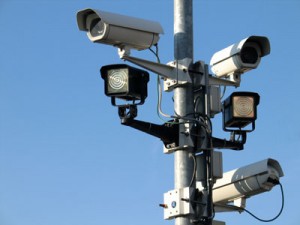Tips for designing a CCTV system with IP cameras spaced far apart.
 With many CCTV systems now working over IP or Ethernet connections rather than analogue connections, it can be a challenge to know how to solve the problem of placing cameras great distances apart without the need for extensive cabling or risking a loss of video quality. If you are installing a CCTV system in a large complex or warehouse and need to achieve long distances between each camera and between the camera and the PoE switch, then you may need to think creatively to solve your problem.
With many CCTV systems now working over IP or Ethernet connections rather than analogue connections, it can be a challenge to know how to solve the problem of placing cameras great distances apart without the need for extensive cabling or risking a loss of video quality. If you are installing a CCTV system in a large complex or warehouse and need to achieve long distances between each camera and between the camera and the PoE switch, then you may need to think creatively to solve your problem.
The issue of power supply
One of the most difficult challenges is sending power to the cameras across long distances. While expanding and installing Ethernet cabling to achieve a greater range is reasonably inexpensive, adding a separate power feed to each camera can be costly and time-consuming, as each connection must be tested and signed off by a competent engineer. Fortunately, developments in cabling and camera technology have enabled Power over Ethernet (PoE), which means that the cameras can draw enough power from the Ethernet cable to operate without an external power supply.
Ethernet cabling…
The simplest way to increase the distance between IP cameras in a network is to create your network using switches, which increases the bandwidth available to each camera for data transfer. PoE extenders can be used to install Ethernet cabling. In some cases, these enable distances of up to 600m.
Or fibreoptic cabling
The other option is to consider going fibreoptic. Fibreoptic cabling is still a more expensive method than Ethernet, but he cost has come down a great deal in the past few years. What will make it cost prohibitive is the need for a professional to install it for you. If you have someone in house who can install fibreoptic cabling then this will be a much more viable solution and will allow you the freedom to extend your network even further in the future should the need arise. If you decide to go with fibreoptic you will need to use media converters at the camera end to send the signal down the cable, and then use patch cables to connect into your switches.
When fibreoptic looks more viable
Although Ethernet extenders are by far the cheapest and easiest solution to install, there are some situations where you will be better off with fibre. In any situation, coaxial Ethernet cabling needs to have outstanding surge and lightning protection, but if you know the cameras are to be mounted outdoors and in an elevated or exposed position, it may be better not to risk it and to go with fibreoptic cabling from the start.
Lightning travels incredibly quickly down the copper cabling inside Ethernet, and can cause an immense amount of damage and a huge fire risk if it makes its way back to your switches or hub. It doesn’t travel in the same way down fibreoptic cabling, so in some situations it will be better to choose this option from a health and safety point of view as much as anything else.
In Summary
When building a digital surveillance system, the setup of the cameras, the digital video recorders (DVR’s) and any hubs and switches will all affect the overall performance of the system, so its important to consider each component of the system individually and make sure it is suitable for your needs. If you are in any doubt then contact a professional systems designer for advice.
Want to understand the complexity of CCTV systems? Get qualified with us
Learn how you can become a pro CCTV installer. Check our CCTV Installation and Maintenance Courses here. For additional information about our distance learning programmes, contact us. The Ministry of Defence has approved our courses for Elcas funding.

